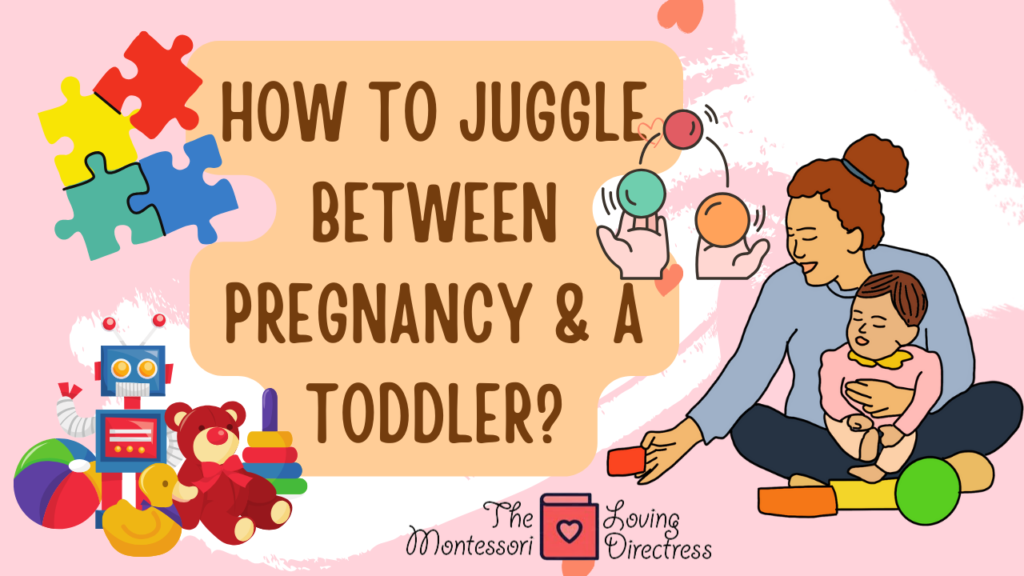Juggling a toddler & pregnancy, this is a guide for managing both. Pregnancy sure is a beautiful journey, but it can become more complex when you already have a toddler to care for. Balancing the needs of your little one while nurturing a new life within you can be overwhelming. However, with some planning, patience, and support, it’s entirely manageable.
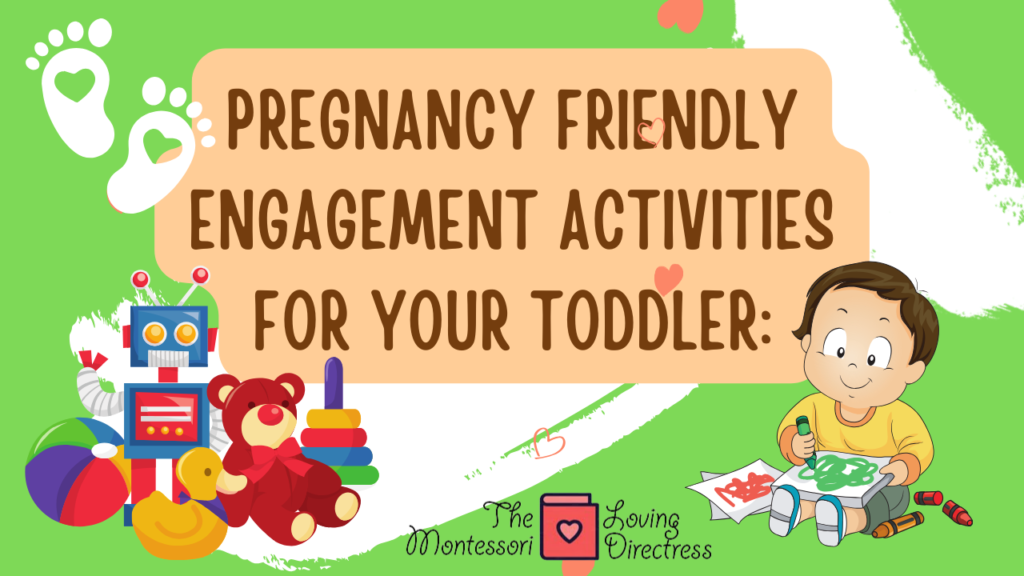
Pregnancy friendly engagement activities for your toddler:
Following activities are designed to keep your toddler entertained and engaged while allowing you to supervise comfortably. It’s essential to create a safe environment for them to explore and play independently while you take care of yourself during this pregnancy. Here are some pregnancy-friendly play ideas for your toddler:
Sensory Play:
- Sensory Bins: Fill a shallow container with rice, pasta, beans, or sand. Add safe toys or objects for your toddler to explore textures and engage their senses.
- Playdough Fun: Use homemade or store-bought playdough for them to squish, roll, and shape. Provide cookie cutters or plastic tools for added creativity.
Quiet Play:
- Story Time: Read books together. Choose interactive or touch-and-feel books to make it more engaging for your toddler.
- Puzzle Play: Offer age-appropriate puzzles. Sit together as your toddler works on them, providing guidance and encouragement.
Imaginative Play:
- Dress-up Time: Gather simple costumes or clothes for dress-up play. Encourage them to pretend to be characters or act out stories.
- Imaginary Worlds: Use blankets or cardboard to create forts or pretend houses where they can play and let their imagination run wild.
Movement and Exploration:
- Obstacle Course: Arrange cushions, pillows, and safe items to create a soft obstacle course for them to crawl or jump over.
- Dance and Music: Play music and have a dance party together. Encourage movement and fun while you relax and enjoy the music.
Creative Expression:
- Art Corner: Set up an art station with crayons, washable markers, papers, and stickers. Let them express themselves creatively.
- Mess-Free Painting: Use large resealable plastic bags filled with paint. Tape them to a window or a table for your toddler to explore painting without the mess.
Learning Activities:
- Shape Sorting: Provide toys or objects of different shapes and sizes for sorting. Use containers or trays for them to categorize.
- Alphabet or Number Games: Introduce simple letter or number recognition games using flashcards, toys, or magnetic letters/numbers.
These play ideas aim to engage your toddler’s senses, creativity, and learning while allowing you to supervise comfortably during your pregnancy. Adapt the activities based on your energy levels and physical comfort, ensuring both you and your toddler enjoy quality time together.

Not being able to pick your toddler during pregnancy?
It’s essential to communicate openly with your toddler and find alternative ways to engage and care for them while considering your physical limitations during pregnancy.
Encourage Independence:
Encourage your toddler to climb onto chairs, sofas, or their bed independently. Offer step stools where needed to promote self-sufficiency.
Modify Your Environment:
Keep frequently used items within their reach. Arrange shelves or drawers at their level so they can access toys, books, and snacks without your assistance.
Use Assistive Devices:
Consider using a stroller, baby carrier, or a wagon for outings or longer walks to avoid carrying your toddler.
Ask for Help:
Enlist the support of family members, friends, or caregivers to assist with lifting and carrying your toddler when necessary.
Create Safe Play Areas:
Designate safe play zones where your toddler can explore and play independently, allowing you to supervise from a seated or comfortable position.
Use Verbal Instructions:
Provide clear instructions or guidance verbally rather than physically moving or lifting your toddler.
Sit and Engage:
Engage in activities where you can comfortably sit or recline while interacting with your toddler, such as reading, puzzles, or playing with toys together.
Modify Your Interactions:
Adapt your interactions to involve activities that don’t require lifting, like cuddling on a sofa or playing with toys while seated.
Communicate Openly:
Explain to your toddler in simple terms why you can’t lift them and reassure them of your love and care.
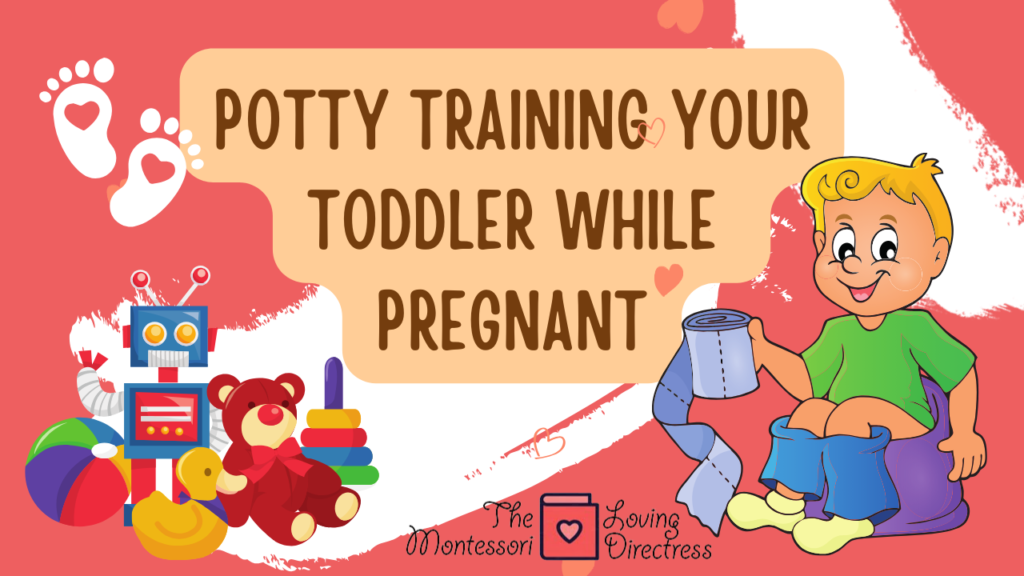
Potty Training your toddler while pregnant:
Potty training during pregnancy without being able to lift your toddler requires patience, consistency, and the support of others. With the following strategies and adaptations, you can navigate this process effectively while considering your physical limitations.
Preparation:
- Choose the Right Time: Ensure both you and your toddler are ready for the process. Look for signs of readiness like showing interest in the potty or having longer dry periods.
- Setup and Accessibility: Place the potty chair in a convenient, easily accessible spot for your toddler. Consider having multiple chairs around the house for quick access.
Adaptations:
- Encourage Independence: Teach your toddler how to undress and dress themselves. Choose clothes that are easy for them to manage independently.
- Use Step Stools: Provide step stools for your toddler to independently climb onto the potty without your assistance.
- Demonstrate and Verbal Guidance: While you may not be able to physically assist, use verbal guidance to instruct them on how to use the potty. Demonstrate the process and provide encouragement.
Consistency and Patience:
- Establish a Routine: Stick to a consistent potty schedule, especially after meals or before naps. Remind your toddler to use the potty regularly.
- Positive Reinforcement: Praise and celebrate successes to encourage your toddler. Consider using a reward system like stickers or small treats.
- Be Patient: Understand that accidents may happen. Stay calm and supportive during setbacks, emphasizing that it’s okay.
Seek Support:
- Enlist Help: Seek assistance from family members or caregivers who can assist your toddler with the potty while you supervise.
- Involve Others: If possible, involve other caregivers in the potty training process so your child gets consistent guidance.
Maintain Self-care:
- Rest and Hydration: Take breaks and stay hydrated. Rest whenever possible to manage your pregnancy while guiding your toddler through potty training.
- Supportive Positions: Use comfortable sitting or reclining positions while supervising your toddler’s potty training to reduce strain on your body.
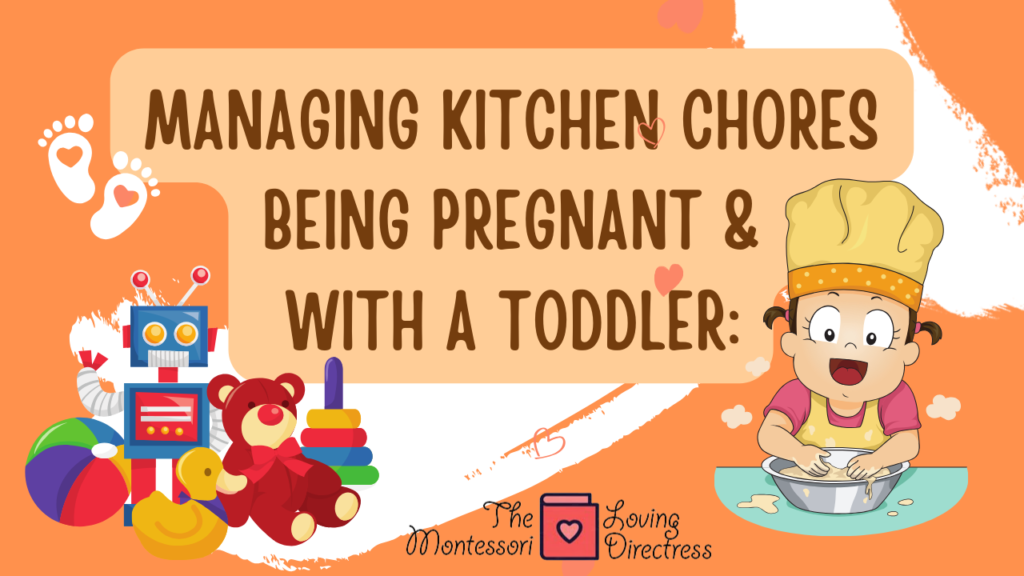
Managing Kitchen chores being pregnant & with a toddler:
Engaging your toddler in safe and age-appropriate activities in the kitchen while you cook alone and pregnant can be a great way to keep them occupied. Here are some ideas:
1. Sorting and Washing Vegetables:
- Give your toddler a small bowl or a colander with veggies (like peas, beans, or cherry tomatoes) to sort or wash under supervision.
2. Stirring and Mixing:
- Allow them to stir pancake or muffin batter in a bowl using a child-safe spoon. It’s a simple yet engaging task.
3. Simple Measuring Tasks:
- Have them help by counting or measuring ingredients like flour or sugar using safe measuring cups or spoons.
4. Tearing Herbs or Greens:
- Offer a small bowl of herbs like parsley or cilantro for them to tear apart. They can also help tear lettuce for a salad.
5. Utensil Play:
- Provide safe kitchen utensils (like plastic spoons or silicone spatulas) for them to play with while you cook. They can pretend to cook alongside you.
6. Safe Chopping or Cutting:
- Use a plastic or child-friendly knife to allow them to chop soft fruits or vegetables (under close supervision).
7. Setting the Table:
- Let them arrange plates, utensils, or napkins on the table for mealtime. It’s a helpful task that also teaches responsibility.
8. Washing Dishes or Utensils:
- If your sink setup allows, offer them some plastic dishes or utensils to wash in a basin of soapy water. It’s a fun and engaging task.
9. Play with Safe Kitchen Items:
- Provide pots, pans, or non-breakable containers for your toddler to play with. They can fill them with water, pretend to cook, or stack them up.
10. Snack Preparation:
- Ask them to help prepare their snacks by spreading nut butter on crackers or arranging fruits on a plate.
Always ensure a safe environment for your toddler by keeping dangerous items out of reach and supervising them closely during kitchen activities. These activities not only keep them engaged but also foster their independence and help them feel involved in meal preparation.
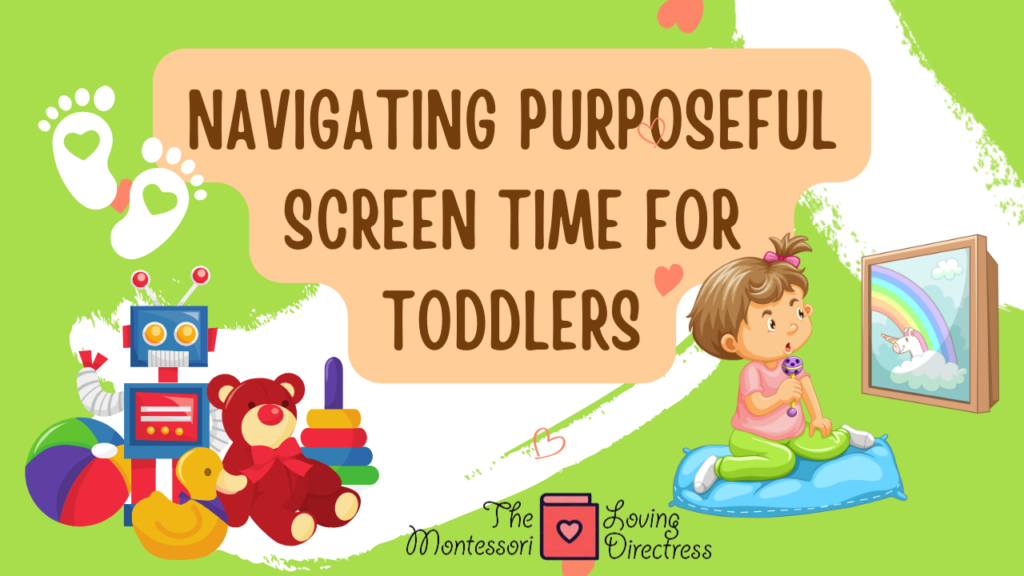
Navigating Purposeful Screen Time for Toddlers:
Purposeful screen time involves engaging, educational content that supports a child’s development without overwhelming stimuli. When handled appropriately, it can offer learning opportunities while allowing a pregnant parent to manage tasks effectively.
In today’s dynamic parenting landscape, managing household chores, pregnancy, and caring for a toddler requires creative strategies. Purposeful screen time for toddlers can be a valuable tool, especially when you’re expecting and juggling multiple responsibilities.
Tips for Implementing Purposeful Screen Time:
- Curate Educational Content:
- Choose apps, games, or shows that align with your toddler’s developmental stage and interests. Look for age-appropriate material that promotes learning, such as letters, numbers, shapes, or vocabulary.
- Set Time Limits:
- Establish specific time slots for screen time during the day. Limit exposure to ensure a healthy balance between digital engagement and other activities.
- Interactive Engagement:
- Encourage your toddler’s active participation while they engage with the screen. Ask questions, discuss content, or participate alongside them when possible.
- Varied Activities:
- Rotate between different types of purposeful screen time activities. Balance educational games, storytelling apps, and quality shows to provide a diverse learning experience.
- Supervised Interaction:
- Maintain supervision during screen time, especially while pregnant and managing household tasks. Stay nearby to ensure your child’s safety and monitor their engagement.
Suggestive Islamic friendly learning shows for toddlers:
“Adam’s World” –
This series features stories about two Muslim children, Adam and Aneesah, who learn about Islamic values, history, and morals through engaging adventures.
“Let’s Learn Quran with Zaky & Friends” –
Zaky, a character loved by children, teaches Islamic values, stories from the Quran, and basic Arabic in a fun and educational manner.
“Barakah Hills” –
An animated series that follows the adventures of the residents of Barakah Hills, teaching Islamic manners, values, and lessons from the Quran through relatable and entertaining stories.
“Little Muslims” –
This show introduces young children to Islamic concepts through simple songs, stories, and basic lessons about the faith.
“Hurray for Baba Ali” –
Baba Ali uses humor and storytelling to teach Islamic morals and values in a way that resonates with children.
These shows offer a mix of entertainment and educational content, presenting Islamic teachings in a child-friendly and engaging manner. Always review the content beforehand to ensure it aligns with your beliefs and values.
Free Educational Resource for toddlers:
Introducing our captivating and versatile free booklet – a treasure trove of educational possibilities! Inside, you’ll find a collection of 26 meticulously crafted, hollow lower case full-size alphabets, designed to inspire creativity and learning in toddlers, teachers, and parents alike.
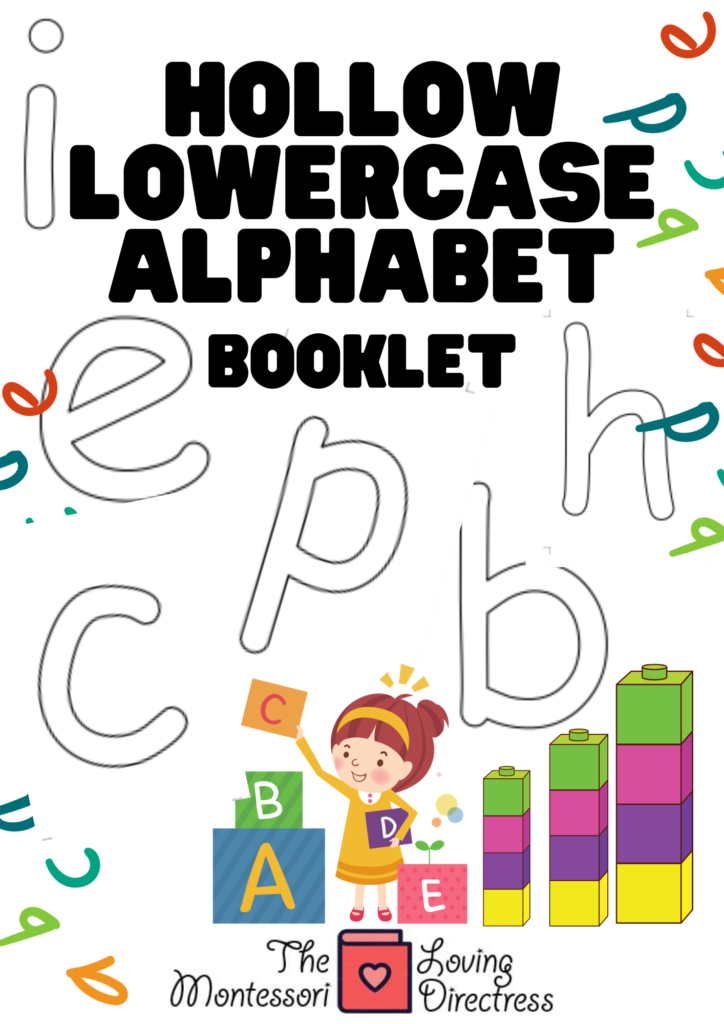
Toddler Pre-Writing Activities:
- Sensory Exploration: Feel the contours and trace the shapes of each letter for tactile learning.
- Filling & Tracing: Fill the letters with various materials (sand, rice, playdough) for sensory engagement.
- Tracing & Drawing: Encourage tracing and drawing within the hollow alphabets to practice pre-writing skills.
Teacher’s Toolbox:
- Letter Recognition & Phonics: Use for interactive lessons on letter identification and phonics exercises.
- Spelling & Word Formation: Engage students in hands-on spelling activities and forming words for interactive learning.
- Creative Teaching Aids: Create tactile alphabet cards or use them for engaging games and scavenger hunts.
Mother-Child Bonding:
- Artistic Stencil Work: Utilize the alphabets as stencils for painting and creative art projects.
- Snack Time Learning: Arrange snacks or fruits in the shape of letters for a fun, educational snack time activity.
- Home Learning Adventures: Foster early literacy skills by incorporating these printables into everyday activities and playtime.

